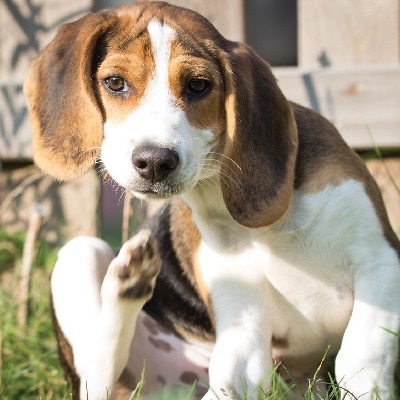 Of all the things that freak pet parents out, hot spots have to be close to number one. Rightfully so, they go from absolutely nothing to a quarter-sized angry blister-looking thing in the span of two hours, and overnight can grow to cover an entire face or other body part! They’re scary but they are mostly manageable as long as they’re treated quickly and correctly. I’m no vet and your vet is always the best person to consult for every ailment your doggie may be faced with, but here are 5 things I’ve learned that might help you if hot spots hit your household!
Of all the things that freak pet parents out, hot spots have to be close to number one. Rightfully so, they go from absolutely nothing to a quarter-sized angry blister-looking thing in the span of two hours, and overnight can grow to cover an entire face or other body part! They’re scary but they are mostly manageable as long as they’re treated quickly and correctly. I’m no vet and your vet is always the best person to consult for every ailment your doggie may be faced with, but here are 5 things I’ve learned that might help you if hot spots hit your household!
YOUR DOG PROBABLY GAVE IT TO HIMSELF. This was a surprise, but essentially what happens is that your dog scratches/licks/paws/or otherwise aggravates a certain area of his skin to the point of rawness (which then spreads like wildfire). He’s probably doing these things because his skin has started itching suddenly, and that itch can come from something as small as a bug bite, a random scratch, an environmental allergy, or even dry skin. When pet parents notice them on their dog their first reaction is usually to panic, worried their dog might have gotten into something that caused a massive allergic reaction or that an actual injury to the skin occurred and it was somehow missed. Not usually the case – usually some tiny thing that just goes wild after your dog scratches!

THEY LOVE SUMMER. A hot spot loves humidity like I love cake. That’s also part of why they occur most of the time on double-coated dogs (golden retrievers, labs, doodles, shepherds, aussies, etc). That double layer of fur is essential to keeping your dog cool in the hot summer, but if your dog has gone swimming or been playing in water, that double coat will hold moisture for a long time thanks to our humid summers. All that moisture can create a happy place for bacteria, which will only help the hot spot get worse even faster! If you have a double coated dog and especially one who loves water, this is the time of year you want to be paying attention and making sure your dog gets fully dry after baths and playtime!

DON’T THROW OUT YOUR HUSBAND’S CLIPPERS. If you take your dog to the vet for a hot spot, you’re going to notice the first thing they do is shave the fur around the spot. This helps aid in getting it to dry out, and also helps keep hair from getting into the sore (they’re pretty oozy and disgusting so you don’t want fur stuck all in it). If one pops up on your dog after hours (remember they spread like wildfire) you can help slow its movement down before the vet opens back up the next day by carefully shaving that fur down around it (as long as you know what you’re doing).
BANDAGE BE GONE! You’re going to be tempted to put some kind of wrap or gauze on these things (did I mention they are gross), but RESIST! Remember moisture is the enemy here and a bandage will only keep the moisture on it. TRY TRY TRY for DRY! If you’re worried about your dog scratching at it without a bandage, unfortunately your best bet is going to be the cone of shame instead. I know, nothing makes us cringe like putting our dogs in a cone but it really is better to leave the hot spot uncovered.
CHECK UNDER COLLARS! Most of the time when we hear of dogs getting these, they happen under the dog’s collar. I think it makes sense; the collar is close to the skin, is a natural place for scratching, and naturally holds moisture between it and the skin if any is present (think about how long it takes your dog’s collar to dry after a swim). Consider taking your dog’s collar off at bedtime to help make sure no moisture is lingering there and give him less of a reason to scratch.
I’ve seen and heard of vets treating these guys in multiple ways (all effective) but the product we always seem to go back to is something called Neo-Predef powder. It’s a prescription so you’ll have to get it through your vet, but the bottles are big enough to treat more than one hot spot so if you have a great relationship with your vet, talk to him about keeping a bottle of it on hand, especially in the summers. It’s a powder that delivers antibiotics AND a bit of a numbing effect, which is helpful since your dog needs to leave it alone in order for it to get on with the healing. (Note: I did hear recently that there is a manufacturer backorder going on with it right now…hoping that ends super soon)
According to the internet there ARE some home remedies out there to assist as well. In my opinion you’re probably going to end up at the vet anyway but I’m sure the OTC products can help give your dog some relief while you’re waiting to get in to see them. Gold Bond medicated powder can be put around the area you’ve shaved to help aid in keeping the hot spot dry, and you can actually make a paste out of that combined with triple antibiotic ointment to apply periodically as well. I also like witch hazel (again a drying agent) on a cotton ball. I’m trying out a new hot spot spray from Vetericyn (they make amazing medicated sprays) next so I’ll be sure to report back with findings!
Whatever you do, just make sure you pay attention to hot spots early and act swiftly. If you have other remedies or tips that have worked for you, feel free to share with the rest of the class! 🙂
Tell your dog I said hi today…. xo Lacey


